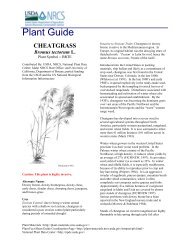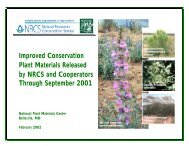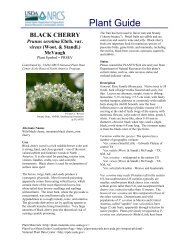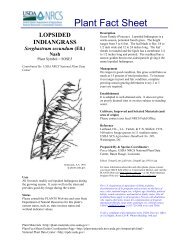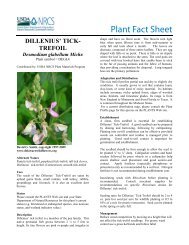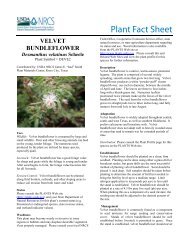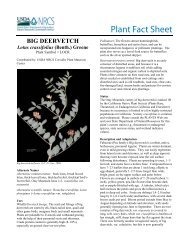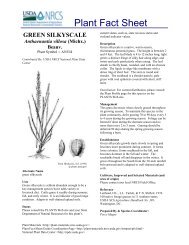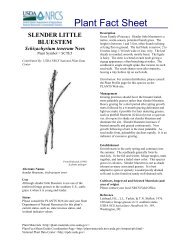Plant guide for Timothy (Phleum pratense) - USDA Plants Database
Plant guide for Timothy (Phleum pratense) - USDA Plants Database
Plant guide for Timothy (Phleum pratense) - USDA Plants Database
You also want an ePaper? Increase the reach of your titles
YUMPU automatically turns print PDFs into web optimized ePapers that Google loves.
TIMOTHY<br />
<strong>Phleum</strong> <strong>pratense</strong> L.<br />
<strong>Plant</strong> Symbol = PHPR3<br />
Contributed by: <strong>USDA</strong> NRCS Idaho State Office<br />
and Aberdeen, Idaho, <strong>Plant</strong> Materials Center<br />
<strong>Timothy</strong> (<strong>Phleum</strong> pretense). James R. Johnson @ <strong>USDA</strong>-NRCS<br />
PLANTS <strong>Database</strong> / <strong>USDA</strong> NRCS. 1992. Western wetland<br />
flora: Field office <strong>guide</strong> to plant species. West Region,<br />
Sacramento.<br />
Alternate Names<br />
Herd grass, herd’s grass, meadow cat's-tail, <strong>Phleum</strong><br />
nodosum<br />
Uses<br />
Livestock: <strong>Timothy</strong> is preferred by cattle and horses,<br />
and timothy hay is a premium feed <strong>for</strong> horses. Sheep<br />
utilize timothy during the summer in mountainous<br />
areas. <strong>Timothy</strong> is used <strong>for</strong> pasture and silage, but<br />
mostly <strong>for</strong> hay. It is palatable and nutritious. It<br />
makes a first rate companion grass with alfalfa,<br />
<strong>Plant</strong> Guide<br />
birdsfoot trefoil, or clover species as it is one of the<br />
grasses least competitive with legumes.<br />
Erosion control: <strong>Timothy</strong> can be used with legumes<br />
and/or other grasses in seed mixtures <strong>for</strong> cover, filter<br />
strips, herbaceous buffers, waterways, and other<br />
critical area applications. It can also be used <strong>for</strong><br />
erosion control on cut- or burned-over <strong>for</strong>estland.<br />
Keep in mind that timothy is shallow-rooted and thus<br />
should not be considered the primary species <strong>for</strong><br />
erosion control plantings.<br />
Wildlife: <strong>Timothy</strong> is commonly found in wildlife seed<br />
mixtures <strong>for</strong> nesting, brood rearing, and escape cover.<br />
Status<br />
Consult the PLANTS Web site and your State<br />
Department of Natural Resources <strong>for</strong> this plant’s<br />
current status (e.g. threatened or endangered species,<br />
state noxious status, and wetland indicator values).<br />
Weediness<br />
<strong>Timothy</strong> is a relatively short-lived, introduced<br />
perennial grass that grows in stools or clumps. It<br />
spreads via seed distribution. It is not considered a<br />
"weedy" or invasive species, but can spread into<br />
adjoining vegetative communities under ideal<br />
climatic and environmental conditions. It is known to<br />
coexist with native plants. On favorable sites where<br />
it is best adapted, it can exist as a monoculture. There<br />
is no documentation that it crosses with native<br />
species. It is considered a weed in seed lots in the<br />
eastern states of Delaware, Maryland, New<br />
Hampshire, New Jersey, Pennsylvania, Virginia and<br />
West Virginia.<br />
Consult with your local NRCS Field Office,<br />
Cooperative Extension Service office, state natural<br />
resource, or state agriculture department regarding its<br />
status and use. Weed in<strong>for</strong>mation is also available<br />
from the PLANTS Web site at http://plants.usda.gov/.<br />
Consult the Related Web Sites on the <strong>Plant</strong> Profile<br />
<strong>for</strong> this species <strong>for</strong> further in<strong>for</strong>mation.<br />
Description<br />
General: Grass family (Poaceae). <strong>Timothy</strong> is a<br />
relatively short-lived, cool-season, introduced<br />
perennial grass that grows in stools or clumps. It has<br />
a shallow, compact, and fibrous root system. It<br />
grows in erect culms 50 to 100 cm (20 to 40 in) tall.<br />
Leaves vary in length from a few inches to more than<br />
a foot and are about 0.6 cm (0.25 in) wide, narrowing<br />
gently toward the tip.
Seedheads are spike-like and dense, from 5 to 15 cm<br />
(2 to 6 in) in length and 0.6 cm (0.25 in) in diameter.<br />
The sheath is split and hairless with overlapping<br />
margins.<br />
<strong>Timothy</strong> is different from most grasses in that one or<br />
occasionally two of the basal internodes of the stem<br />
swell into a bulb-like growth called a “haplacorm”.<br />
This characteristic is often used <strong>for</strong> identification of<br />
the plant during its early stages of growth.<br />
<strong>Timothy</strong> resembles the “native” alpine timothy (P.<br />
alpinum) to some extent. Alpine timothy is usually<br />
found in alpine meadows and bogs and occasionally<br />
at medium elevations along the west coast. Alpine<br />
timothy usually flowers in late July to early August in<br />
the mountains. The seedheads of alpine timothy are<br />
much shorter and the plant is also shorter in stature<br />
than timothy.<br />
<strong>Timothy</strong> is also confused with meadow foxtail<br />
(Alopecurus pratensis) and creeping foxtail (A.<br />
arundinaceus). Meadow and creeping foxtail have<br />
short twisted awns giving the inflorescence a<br />
somewhat fuzzy appearance. <strong>Timothy</strong> is awnless.<br />
Additionally, cured seed heads of creeping foxtail<br />
have a dark to somewhat black appearance, while<br />
cured seed heads of timothy are tan to buff colored.<br />
Alpine timothy <strong>Timothy</strong><br />
Creeping<br />
foxtail<br />
Differences in seedhead morphology between alpine timothy,<br />
timothy, and creeping foxtail. Ben Zamora, Oregon State<br />
University, Range <strong>Plant</strong>Leaflet No. 47. Seed head examples are<br />
not to scale.<br />
Seed is very small and usually remains enclosed in<br />
the glumes. There are approximately 1,230,000<br />
seeds per pound.<br />
<strong>Timothy</strong> seed. Steve Hurst. Provided by ARS Systematic<br />
Botany and Mycology Laboratory.<br />
Distribution: <strong>Timothy</strong> is distributed throughout the<br />
entire United States; however, it grows best in the<br />
northern half of the nation and along mountain chains<br />
further south.<br />
Agricultural use of timothy in the U.S. occurs<br />
primarily in the Northwest, upper Midwest, and<br />
Northeast. For a current distribution map, consult the<br />
<strong>Plant</strong> Profile page <strong>for</strong> this species on the PLANTS<br />
Website.<br />
Habitat: <strong>Timothy</strong> can be found growing in<br />
waterways, dry to wet meadows and other mesic<br />
environments. It is commonly found volunteering in<br />
canals and roadside borrow ditches.<br />
Adaptation<br />
<strong>Timothy</strong> is an introduced bunchgrass adapted to cool,<br />
humid areas and to high elevations. It per<strong>for</strong>ms well,<br />
with moderate to high yields, on wet fertile lands. It<br />
is adapted to irrigation and areas with effective<br />
annual precipitation of at least 45 cm (18 in). It<br />
prefers finer textured soils, such as clays to clay<br />
loams to loams and is adapted to soils with a pH of<br />
5.5 to 7.0. It is tolerant of partially shaded conditions.<br />
<strong>Timothy</strong> is very winter-hardy. It exhibits tolerance to<br />
both cold temperature, and ice encasement, a major<br />
factor affecting winter survival. It is not well adapted<br />
to wet, flat land where water stands <strong>for</strong> extended<br />
periods of time, though it can withstand somewhat<br />
poorly-drained soils. It does not tolerate drought or<br />
prolonged high temperatures and it does not tolerate<br />
alkaline conditions.<br />
<strong>Timothy</strong> is compatible in mixes with legumes. It<br />
establishes cover quickly, volunteers readily on<br />
preferred sites, is late maturing, and is very palatable<br />
early in the growing season (jointing stage) and only<br />
moderately palatable later in the growing season<br />
(post seedhead development). <strong>Timothy</strong> hay is a<br />
premium feed <strong>for</strong> horses and is compatible in legume<br />
mixes. Severe damage can result from early grazing<br />
under wet conditions. It regrows very slowly<br />
following grazing or haying. Other recommended<br />
sites include cool, moist meadows and open <strong>for</strong>ests.<br />
<strong>Timothy</strong> establishes quickly and volunteers readily<br />
on preferred sites. It invades wet areas along ditches,<br />
canals, drains, and streams and can be a weed in<br />
these areas.<br />
Establishment<br />
<strong>Timothy</strong> is usually seeded in mixtures with legumes.<br />
This mixture may be planted with a small grain. If<br />
planted with a winter grain, the timothy is seeded<br />
with the grain in the fall, and the legume is planted<br />
early the following spring. Seeding depth of timothy<br />
should be about 0.3 to 1.3 cm (0.125 to 0.5 in). A<br />
firm, weed-free seedbed is a key to a successful<br />
planting. Common seeding rates are 3 to 6 pounds
per acre when seeded alone and 1 to 3 pounds per<br />
acre when seeded in mixtures. The average number<br />
of seeds per square foot at 1 lb. seeding rate is 28<br />
seeds. Seeding rates should be doubled if seed is<br />
broadcast planted.<br />
Management<br />
<strong>Timothy</strong> is a short-lived, shallow-rooted, introduced,<br />
perennial bunchgrass. In spring, the crowns <strong>for</strong>m<br />
swollen, bulblike internodes that store energy. Close<br />
grazing and trampling during moist conditions can<br />
damage these internodes and severely reduce stands.<br />
<strong>Timothy</strong> should be grazed be<strong>for</strong>e the jointing stage<br />
and hayed be<strong>for</strong>e seed heads have emerged from boot<br />
to early bloom stage. Begin grazing during the<br />
vegetative stage, after grass has reached at least 15<br />
cm (6 in) in height. A 10 cm (4 in) stubble height<br />
should remain following grazing. It regrows slowly<br />
following grazing or haying. A 28 to 35 day recovery<br />
period between grazing or haying cycles is<br />
recommended.<br />
<strong>Timothy</strong> is highly responsive to fertilizers, which<br />
should be applied frequently based in accordance<br />
with soil tests. Fertilizer, especially nitrogen, is<br />
important when legumes such as clover species have<br />
almost disappeared from the hay or pasture mixture.<br />
<strong>Timothy</strong> stands become weak under close and<br />
continuous grazing. A fundamental reason <strong>for</strong> the<br />
decline of timothy under poor grazing practices is<br />
injury to the bulblets (haplacorm). These bulblets<br />
<strong>for</strong>m in the spring at the same time the stem<br />
elongates. Food reserves are stored in the bulblets,<br />
and they may be destroyed through trampling by<br />
grazing animals in the spring.<br />
<strong>Timothy</strong> can be initially grazed be<strong>for</strong>e jointing and<br />
again between early head to full head. Second and<br />
successive grazing periods should occur be<strong>for</strong>e<br />
jointing and when basal sprouts appear at the soil<br />
surface. After the second grazing period, plants<br />
usually do not joint; there<strong>for</strong>e, sprouts are the<br />
primary grazing <strong>guide</strong>. <strong>Timothy</strong> should be cut <strong>for</strong><br />
hay or silage from boot stage to early head or<br />
flowering stage. Make successive harvests <strong>for</strong> hay<br />
and silage when basal sprouts appear at the soil<br />
surface. Sterile seed-heads may be 38 to 50 cm (15<br />
to 20 in) up the stems when sprouts appear at the time<br />
of second cutting. Growing points stay below ground<br />
level after the second cutting. Graze or cut to heights<br />
of 10 cm (4 in) or more.<br />
Pests and Potential Problems<br />
Stem rust is a disease that can cause loss of vigor and<br />
<strong>for</strong>age quality to timothy. Rust-resistant varieties<br />
have been developed to control this disease. Purple<br />
eyespot (Cladosporium phlei) and leaf streak<br />
(Drechslera phlei) are diseases commonly found<br />
across western Canada. <strong>Timothy</strong> is also damaged by<br />
brown leaf blight and grasshoppers. New fields are<br />
also susceptible to wireworm or cutworms. European<br />
skipper larvae (a bright orange butterfly) are a pest of<br />
timothy in eastern Canada.<br />
Seed Production<br />
Seed production fields should be soil tested be<strong>for</strong>e<br />
planting to determine soil nutrient levels and fertilizer<br />
needs. Seed should be drilled or broadcast into a<br />
weed free, firm seedbed. The optimum seeding depth<br />
is 0.3 to 1.3 cm (0.125 to 0.5 in). The drill seeding<br />
rate of 1 to 2 pounds PLS per acre in 45 to 60 cm (18<br />
to 24 in) rows provides a good stand. Wider row<br />
spacing may be beneficial to seed production in dry<br />
climates.<br />
Under irrigated conditions, seed yields average 450<br />
to 670 kg/ha (400 to 500 lb/ac). Seed production<br />
under dryland conditions is not recommended in the<br />
western United States. In the eastern United States,<br />
seed production yields of 336 to 450 kg/ha (300 to<br />
400 lb/ac) can be expected.<br />
<strong>Timothy</strong> shatters readily but should not be swathed<br />
too soon. It is usually ready to swath when 5 to 10<br />
percent of the seed have shattered (late July to early<br />
August). The seedheads will have a tan color and the<br />
stems and leaves will be a golden color. Swathing<br />
early in the morning will help reduce seed shatter.<br />
Allow 5 to 14 days of drying be<strong>for</strong>e combining.<br />
Cultivars, Improved, and Selected Materials (and<br />
area of origin)<br />
Most of the timothy grown in the U.S. is common<br />
timothy. Improved cultivars and places of<br />
development are: ‘Essex’ and ‘Cornell 1777’ (New<br />
York); ‘Lorain’ and ‘Marietta’ (Ohio); ‘Itasca’<br />
(Minnesota); ‘Clair’ (Kentucky), and ‘Verdant’<br />
(Wisconsin). Canadian releases are ‘Bounty’,<br />
‘Climax’, ‘Drummond’, ‘Medon’, ‘Milton’, ‘Paton’,<br />
and ‘Swallow’. Common timothy and most cultivars<br />
can be readily obtained from commercial sources.<br />
There are many proprietary timothy varieties grown<br />
under contract <strong>for</strong> seed companies.<br />
References<br />
Agriculture and Agri-Food Canada. 2004. <strong>Timothy</strong><br />
Seed Production in Western Canada. Online at:<br />
http://www1.agric.gov.ab.ca/$Department/deptd<br />
ocs.nsf/all/agdex8696. [accessed Aug. 27, 2009].<br />
Alderson, J. and WC Sharp 1994. Grass varieties in<br />
the United States. Agriculture Handbook No.<br />
170. <strong>USDA</strong>, SCS, Washington, D.C.<br />
Barkworth, Mary, et. al. 2007. Manual of grasses <strong>for</strong><br />
North America. Intermountain Herbarium and<br />
Utah State University Press, Logan, Utah.<br />
Cronquist, A., AH Holmgren, NH. Holmgren, JL.<br />
Reveal, & PK. Holmgren 1977. Intermountain<br />
flora. Vol. 6. The New York Botanical Garden.
Columbia University Press, New York, New<br />
York.<br />
Hitchcock, AS. 1950. Manual of the grasses of the<br />
United States. <strong>USDA</strong>, Washington, DC.<br />
Holzworth, LK. and LE. Wiesner. 1985. Grass and<br />
Legume Seed Production in Montana and<br />
Wyoming. <strong>USDA</strong>-SCS Bridger <strong>Plant</strong> Materials<br />
Center. 31 p.<br />
Majerus, M. 2009. Forage and Reclamation Grasse<br />
of the Northern Great Plains and Rocky<br />
Mountains Valley Printers, Bridger, Montana.<br />
McElroy, AR and H.T. Kunelius. 1995. Timonthy.<br />
Pp. 305-311 in R.F. Barnes, D.A. Miller and C.J.<br />
Nelson (eds.) Forages volume I: An introduction<br />
to grassland agriculture. Iowa State University<br />
Press, Ames.<br />
<strong>USDA</strong>, Forest Service 1996. Fire effects in<strong>for</strong>mation<br />
system. Version: 000413.<br />
. Rocky<br />
Mountain Research Station, Fire Sciences<br />
Laboratory, Missoula, Montana.<br />
<strong>USDA</strong>, NRCS 2000. The PLANTS database.<br />
Version: 000413. .<br />
National <strong>Plant</strong> Data Center, Baton Rouge,<br />
Louisiana.<br />
Zamora, Ben, Oregon State University, Range <strong>Plant</strong><br />
Leaflet No. 47. Corvallis, Oregon<br />
Prepared By:<br />
Daniel G. Ogle, <strong>Plant</strong> Materials Specialist <strong>USDA</strong><br />
NRCS, Boise, ID<br />
Loren St. John, Team Leader, <strong>USDA</strong> NRCS, <strong>Plant</strong><br />
Materials Center, Aberdeen, ID<br />
Derek J. Tilley, Agronomist, <strong>USDA</strong> NRCS, <strong>Plant</strong><br />
Materials Center, Aberdeen, ID<br />
Edited: 07Oct2009jfh; 10Oct2009mws; 18Mar2011dgo; 18Mar2011lsj;<br />
18Mar2011djt;<br />
Citation<br />
Ogle, DG, St. John, L and DJ Tilley. 2011. <strong>Plant</strong><br />
<strong>guide</strong> <strong>for</strong> timothy (<strong>Phleum</strong> <strong>pratense</strong>). <strong>USDA</strong>-Natural<br />
Resources Conservation Service, Idaho State Office.<br />
Boise, ID.<br />
Published March, 2011<br />
For more in<strong>for</strong>mation about this and other plants,<br />
please contact your local NRCS field office or<br />
Conservation District at http://www.nrcs.usda.gov/<br />
and visit the PLANTS Web site at<br />
http://plants.usda.gov/ or the <strong>Plant</strong> Materials Program<br />
Web site http://plant-materials.nrcs.usda.gov.<br />
PLANTS is not responsible <strong>for</strong> the content or<br />
availability of other Web sites.<br />
<strong>USDA</strong> IS AN EQUAL OPPORTUNITY PROVIDER AND EMPLOYER



